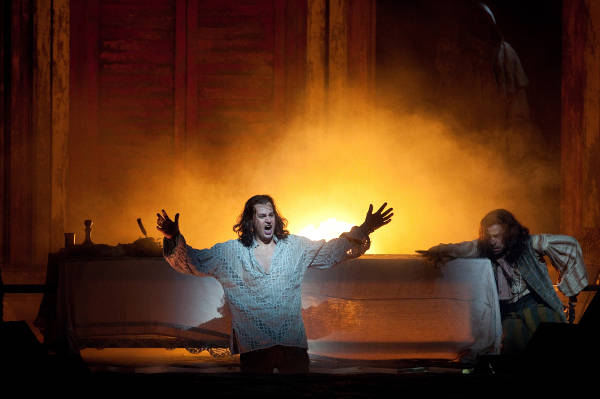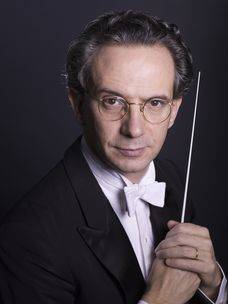Classical New York 3.0
The Metropolitan Opera is a little more Italian, this year. The big news this summer was that, due to health reasons, Music Director James Levine was handing the position of Principal Conductor to Fabio Luisi, already Principal Conductor of the Vienna Symphony and future Generalmusikdirektor of the Zurich Opera. He was already scheduled to conduct Massenet's Manon and La Traviata in the spring, but had to take over Levine's Don Giovanni and Siegfried this fall. Levine is still Music Director and is still scheduled to appear regularly in 2012.
Meanwhile the season has begun. The opera chosen as the season opener (September 26) is
Donizetti's Anna Bolena, his first success back in 1830, eclipsed in time by his common repertoire works Lucia di Lamermoor, Don Pasquale and L'Elisir d'amore. In fact, this is the Met premiere of the work, entrusted to the expert hands of Marco Armiliato, by now a veteran of everything Italian at the opera house. Anna Netrebko stars as the unlucky heroine, decapitated by her husband, King Henry VIII (Ildar Abdrazakov) in order to marry his third wife, Jane Seymour (Ekaterina Gubanova), Anna's lady-in-waiting.
The production was directed by David McVicar, whose successful production of Il Trovatore in 2009 has been a constant presence during these past seasons. McVicar was the right choice for Anna Bolena, since the opera calls for the kind of elegance and fluidity that the director had demonstrated in his previous work. Premiering such an opera at the Met with a more contemporary approach would probably not have worked as well. McVicar uses massive walls to depict Anna's solitude and confinement (both physical and mental), moving them around to allow changes in locations (including a scene in the woods where trees suddenly sprout down from the elegant palace ceilings), and literally uprooting the whole set for the beautiful climactic final scene in the dungeons, where Anna faces execution while, off stage, the new Queen is being crowned.
It is remarkable to notice that until October 27 (the opening night of Robert Lepage's new production of Wagner's Siegfried), every performance of this season will have been in Italian. Also, for a whole month after that, only Siegfried (German) and Satyagraha (English) will be in any other language. Among the more common Italian repertoire on display is Bartlett Sher's popular 2006 production of Rossini's Il Barbiere di Siviglia, always an audience favorite, led as before by Maurizio Benini, a fantastic conductor when it comes to early 19th-century Italian opera.
On stage, Swedish baritone Peter Mattei enchanted the audience in the title role, countered by the expert Italian buffo bass Maurizio Muraro, who will be back this winter as Sulpice in Donizetti's La Fille du Régiment. Mezzo-soprano Isabel Leonard was terrific as Rosina,
contributing to the top-notch acting of the whole cast, with the substantial contribution of guest artist Rob Besserer, in the mute comic role of the servant Ambrogio, gaining the most laughs from the house.
Another new production, this season, is Mozart's dramma giocoso Don Giovanni, conducted by Luisi, who is also providing the harpsichord continuo. Mariusz Kwiecien was supposed to star as the famous ladies’ man, but he injured himself during the dress rehearsal, and is being replaced in the first performances by Mattei, borrowed from the Barbiere cast. In the opera he is pursued by one of his ex-lovers Donna Elvira (Barbara Frittoli), his enemies Donna Anna (Marina Rebeka) and Don Ottavio (Ramòn Vargas), and is brought to his demise by the ghost of the late Commendatore (Stefan Kocan). Through all this he is accompanied by his unhappy servant Leporello, sung by the terrific Italian bass-baritone Luca Pisaroni.
Pisaroni was present at NYU's Casa Italiana Zerilli-Marimò on Friday, October 14, for the series Adventures in Italian Opera with Fred Plotkin and spoke about his formative experience and his approach to baroque opera and to Mozart's music. "In Italy, if you don't sing Puccini, Verdi, Bellini, Donizetti, you're not considered a real singer", he said. "My voice teacher at the conservatory wanted me to sing Zaccaria [from Verdi's Nabucco] in my third year", adding that he though he would wind up singing Wotan by the fifth. He explained that the repertoire he sings allows one to grow without damaging the delicate instrument that is the human voice. This is thanks to the lighter orchestration and the lack of sustained notes in the high register.
About playing Don Giovanni's servant, Pisaroni suggested that the role is successful when the singer conveys how much Leporello enjoys being the servant, conveying the idea that - as much as he might wish it - he will never be like his master. "His life has a meaning because he lives it through Don Giovanni", he said. Don Giovanni, he added, is the engine of the opera and changes the lives of the other characters. "I don't believe in the happy ending. When he dies everybody has a sense of loss".
The new production, directed by Michael Grandage, at his Met debut, is smart and functional, alternating tight proscenium moments such as the Act I duel and the Act II sextet with wider spaces for the scenes with the chorus and the two finales. The large sets by Christopher Oram, rows of tall condominium-style buildings enclose and release the space as if they were a curtain, while the final scene, in which Don Giovanni is dragged to the fiery pits of Hell is achieved with pyrotechnics.
Peter Gelb's greatest achievement as the Met's General Manager is certainly the successful High Defenition live broadcasting of the season's highlights around the world. This year, the Italian film distribution company Nexo Digital announced that it would broadcast eleven performances from the Met in forty Italian cinemas. For those who read this from the Bel Paese, www.nexodigital.it includes all the necessary schedule and location information.
A terrific season awaits us at the Met, and it is exciting to know that opera lovers around the world are gathering to take part in it, even (and finally) in the land that gave birth to this art form over 400 years ago.





































i-Italy
Facebook
Google+
This work may not be reproduced, in whole or in part, without prior written permission.
Questo lavoro non può essere riprodotto, in tutto o in parte, senza permesso scritto.